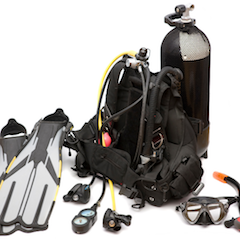Scuba diving is a phenomenal activity, and one that requires knowledge, preparation and of course the right equipment. Taking care of our scuba equipment between dives is an extremely important thing to do, and it has a primary role in keeping us safe and comfortable, and avoiding any type of incidents or accidents underwater. Our lives depend on each and any piece of equipment while we are diving, and we need to trust it in order to explore safely the underwater realm, a place that we are certainly otherwise not designed to experience.
During your dive courses, you have been taught how important it is to own your own gear: compared to rental equipment, you know your own gear inside out, you get comfortable with that specific model by using it more and more times; the wetsuit fits you perfectly, no adjustments are needed, you know exactly if it has any defects and you can take care of it personally, knowing also that it is sanitized and you don’t need to worry about hygiene or any malfunction.
Regular professional maintenance is required for regulators and buoyancy control devices, and some computers need professional assistance even to replace batteries, but there are plenty of procedures that you can undergo to take care of your equipment personally and give it the chance to last longer and function perfectly for many years.
Let’s see how to maintain every piece of your equipment:
- Masks: The straps of dive masks need to be inspected regularly and they are very easy to replace if they start breaking up. We actually recommend every diver to have a couple of spare mask straps in their maintenance kit. As to the lenses, rinse them always with fresh water and do not leave them in the sun. If the mask is fogging up, you can either gently burn the inside with a lighter or leave some toothpaste in overnight: both techniques will eliminate the protective wax that makes your mask fog up. Gents, shave your moustache or use special beard wax to keep facial hair from allowing water in your mask.
- Snorkel: The snorkel is an important complement to your dive gear, especially if you dive in areas that require long swims. Ensure it is always free from obstructions, clean it with fresh water, and replace the mouthpiece whenever needed.
- Exposure suit and neoprene accessories: A wetsuit will simply need to be washed with fresh water and stored in a closet, on a hanger, not folded (that would ruin the neoprene). Wetsuits can also be washed from time to time in washing machines: cold water and softener will do. The same treatments go for gloves, boots and hoods. Do not use a machine to wash semidry or dry suits, though, as the neck and wrist areas, as well as the dry zip, will probably get damaged. Semi-dry and dry suits need to be washed only by hand, with fresh water, hung to rinse and to rest between dives. Hanging dry suits inside out is a common practice to allow the internal part to lose any bad smell due to sweat or body odors. Always inspect seals and zip, use the manufacturer’s wax to treat your dry zip, especially if you do not use the dry suit for a few months. If the seals on the neck or the wrists are getting thinner or are starting to open up, have them replaced by a professional ASAP. Leave some talc on these areas when you store your suit. The dry zip and the seals are definitely the most delicate and expensive parts to replace in your exposure suit.
- Buoyancy Control Device: Together with the regulators, this is literally the heart of your dive equipment, the most important in terms of maintenance and the one that requires some extra care. BCDs can be pricey but they can also last you a lifetime, provided that you take good care of them. Between dives, always rinse them INSIDE and OUTSIDE with fresh water. Washing it on the outside is pretty easy and straightforward, but what about the inner layer? You should have learned how to do that in your Open Water Diver course: press the deflator button, let water inside through a hose or a sink, and fill the BCD with water. Shake it to ensure that fresh water is rinsing potential salt from every corner, then use the purge button to empty it. Blow some air in through the mouthpiece, it and let it dry. Store it with some air in it, so the internal walls won’t glue to each other, especially in hot weather. Regularly inspect the dump valves and the inflator hose, and take it to a professional if further work is needed.
- Regulators and instruments: The most valuable, expensive and probably important piece of your equipment is the group composed by regulators and instruments. This assembly of tools is very simply what keeps you alive underwater, so you want to take extremely good care of it. After a dive, ensure the first stage is covered with a proper cap. Rinse it with a hose or submerge it in a rinse tank, the fresh water will wash away any salt incrustation that might damage the gear. Do not press the regulators’ purge button as this might let some water reach the first stage and damage it. Pull and release the inflator hose, and inspect your pressure gauge for any foreign objects – such as sand, salt or water. If you feel the regulator does not provide air as usual, or it has a bad taste, or makes some odd sounds, take it to a technician for a thorough inspection and repair. With a spare mouthpiece and a cable tie, you can simply replace mouthpieces whenever they break due to regular wear and tear.
- Fins: simply inspect your fin straps for any damage, and keep a spare set in your maintenance tool kit. Rinse them thoroughly, especially if your model has metal springs. If you use full foot fins, you will need to replace the fin once the rubber around the foot starts breaking.
- Dive computer: the dive computer is another of those instruments that will cost you some money, but will also last you for a very long time. Maintenance and battery replacement can vary based on the model, so read the manufacturer’s instructions. Some models allow you to replace the battery – and in that case make sure you do it in a clean and dry environment, you grease the O-ring, and seal the computer properly once finished – others will require the assistance of a professional and a pressure test.
- Tank, weights and accessories: you might not own a tank, as most divers use those provided by the dive shop, but if you do you will know some inspections and checks are required at given times. Any fall, hit or potential bending of the material can result in a damage that can affect your safety underwater. In general, between dives, ensure the cylinder is washed with fresh water and has no residues of sand on or around it. Remove the boot, if any, to wash it everywhere, let it dry and store it safely. Weights only need to be rinsed and stored, pay a little extra attention to the buckle.
The PADI Equipment Specialist Course
For those divers that want to know more about care and maintenance of their equipment, or that might be interested, in the future, in becoming service technicians for BCDs, computers or regulators, and are looking for a start point of this type of training, PADI offers the Equipment Specialist course. During this brief and hands-on course, students will learn more about the equipment and how it works, how it is made, and the parts that compose it. On top of this, your instructor will teach you tricks and techniques to solve potential problems with your gear: you don’t want to miss a dive for a minor technical complication! They will teach you some basic repairs – such as O-ring replacement or fixing a tear in your wetsuit – and how to maximize the lifespan of your equipment, while cleaning and maintaining your gear and creating a “save-a-dive” tool kit. This course is recommended to divers of all levels and age, as it can be taken right after a Scuba Diver certification, and at a minimum age of 10 years old.

